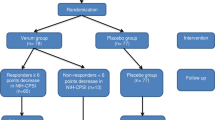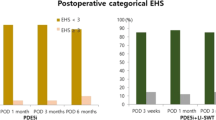Abstract
Erectile dysfunction (ED) is common in patients with pelvic fractures associated with urethral injury (PFUI). We aim to assess the efficacy and safety of low-intensity shock wave therapy (LiSWT) in ED treatment related to PFUI. Forty-three consecutive patients with PFUI who underwent surgical repair between January 2014 and March 2017 were sampled in Kaohsiung Medical University Hospital, Kaohsiung, Taiwan. ED onset following surgical repair was initially treated with oral phosphodiesterase type 5 inhibitors (PDE5i) for six months. PDE5i non-responders were referred for LiSWT of six weekly sessions. Erectile function was evaluated by the International Index of Erectile Function-5 (IIEF-5) and Erection Hardness Score (EHS). Forty-three consecutive patients were enrolled in our study. ED was observed in 79.1% (34/43) patients following surgical repair. These 34 patients were given oral PDE5i (Tadalafil® 5 mg) daily treatment, 64.7% (22/34) patients restored erectile function to normal range (EHS: 3.4 ± 1.3, IIEF-5: 21.7 ± 1.0). The other twelve PDE5i non-responders were referred for LiSWT. Seven patients (58.3%, 7/12) remained unable to maintain the rigidity for full sexual intercourse. The other five patients reported allowing full sexual intercourse. Based on our results, LiSWT may ameliorate the ED in men with PFUI and shift PDE5i non-responders to responders.
This is a preview of subscription content, access via your institution
Access options
Subscribe to this journal
Receive 8 print issues and online access
$259.00 per year
only $32.38 per issue
Buy this article
- Purchase on Springer Link
- Instant access to full article PDF
Prices may be subject to local taxes which are calculated during checkout

Similar content being viewed by others
References
Johannes CB, Araujo AB, Feldman HA, Derby CA, Kleinman KP, McKinlay JB. Incidence of erectile dysfunction in men 40 to 69 years old: longitudinal results from the Massachusetts male aging study. J Urol. 2000;163:460–3.
NIH consensus conference. NIH consensus development panel on impotemce. Conf Impot JAMA. 1993;270:83–90.
Soterio-Pires JH, Hirotsu C, Kim LJ, Bittencourt L, Tufik S, Andersen ML. The interaction between erectile dysfunction complaints and depression in men: a cross-sectional study about sleep, hormones and quality of life. Int J Impot Res. 2017;29:70–75.
Hatzimouratidis K, Amar E, Eardley I, et al. Guidelines on male sexual dysfunction: erectile dysfunction and premature ejaculation. Eur Urol. 2010;57:804–14.
Olsen AB, Persiani M, Boie S, Hanna M, Lund L. Can low-intensity extracorporeal shockwave therapy improve erectile dysfunction? A prospective, randomized, double-blind, placebo-controlled study. Scand J Urol. 2015;49:329–33.
Vardi Y, Appel B, Jacob G, Massarwi O, Gruenwald I. Can low-intensity extracorporeal shockwave therapy improve erectile function? A 6-month follow-up pilot study in patients with organic erectile dysfunction. Eur Urol. 2010;58:243–8.
Sokolakis I, Dimitriadis F, Psalla D, Karakiulakis G, Kalyvianakis D, Hatzichristou D. Effects of low-intensity shock wave therapy (LiST) on the erectile tissue of naturally aged rats. Int J Impot Res. 2018. https://doi.org/10.1038/s41443-018-0064-0. [Epub ahead of print]
Shenfeld OZ, Kiselgorf D, Gofrit ON, et al. The incidence and causes of erectile dysfunction after pelvic fractures associated with posterior urethral disruption. J Urol. 2003;169:2173–6.
Fu Q, Zhang J, Sa YL, Jin SB, Xu YM. Recurrence and complications after transperineal bulboprostatic anastomosis for posterior urethral strictures resulting from pelvic fracture: a retrospective study from a urethral referral centre. BJU Int. 2013;112:358–63.
Johnsen NV, Kaufman MR, Dmochowski RR, Milam DF. Erectile dysfunction following pelvic fracture urethral injury. Sex Med Rev. 2018;6:114–23.
El-Assmy A, Harraz AM, Benhassan M, Nabeeh A, Ibrahiem, el H. Erectile function after anastomotic urethroplasty for pelvic fracture urethral injuries. Int J Impot Res. 2016;28:139–42.
Moore EE, Cogbill TH, Jurkovich GJ, et al. Organ injury scaling. III: chest wall, abdominal vascular, ureter, bladder, and urethra. J Trauma. 1992;33:337–9.
Rosen RC, Cappelleri JC, Smith MD, Lipsky J, Peña BM. Development and evaluation of an abridged, 5-item version of the International Index of Erectile Function (IIEF-5) as a diagnostic tool for erectile dysfunction. Int J Impot Res. 1999;11:319–26.
Goldstein I, Mulhall JP, Bushmakin AG, et al. The erection hardness score and its relationship to successful sexual intercourse. J Sex Med. 2008;5:2374–80.
Scarberry K, Bonomo J, Gómez RG. Delayed posterior urethroplasty following pelvic fracture urethral injury: do we have to wait 3 months? Urology. 2018;116:193–7.
Andrich DE, Day AC, Mundy AR. Proposed mechanisms of lower urinary tract injury in fractures of the pelvic ring. BJU Int. 2007;100:567–73.
Shenfeld OZ, Gofrit ON, Gdor Y, et al. The role of sildenafil in the treatment of erectile dysfunction in patients with pelvic fracture urethral disruption. J Urol. 2004;172:2350–2.
Peng J, Zhang Z, Cui W, et al. Role of nocturnal penile erection test on response to daily sildenafil in patients with erectile dysfunction due to pelvic fracture urethral disruption: a single-center experience. Urology. 2014;84:1389–94.
Carvalheira AA, Pereira NM, Maroco J, Forjaz V. Dropout in the treatment of erectile dysfunction with PDE5: a study on predictors and a qualitative analysis of reasons for discontinuation. J Sex Med. 2012;9:2361–9.
Moemen MN, Hamed HA, Kamel II, Shamloul RM, Ghanem HM. Clinical and sonographic assessment of the side effects of intracavernous injection of vasoactive substances. Int J Impot Res. 2004;16:143–5.
Bechara A, Casabé A, De Bonis W, Ciciclia PG. Twelve-month efficacy and safety of low-intensity shockwave therapy for erectile dysfunction in patients who do not respond to phosphodiesterase type 5 inhibitors. Sex Med. 2016;4:225–32.
Li H, Matheu MP, Sun F, et al. Low-energy shock wave therapy ameliorates erectile dysfunction in a pelvic neurovascular injuries rat model. J Sex Med. 2016;13:22–32.
Tepeköylü C, Wang FS, Kozaryn R, et al. Shock wave treatment induces angiogenesis 15 and mobilizes endogenous CD31/CD34-positive endothelial cells in a hindlimb ischemia model: implications for angiogenesis and vasculogenesis. J Thorac Cardiovasc Surg. 2013;146:971–8.
Author information
Authors and Affiliations
Corresponding author
Ethics declarations
Conflict of interest
The authors declare that they have no conflict of interest.
Rights and permissions
About this article
Cite this article
Wang, CJ., Lu, YM., Li, CC. et al. Low-intensity shock wave therapy ameliorates erectile dysfunction in men with pelvic fractures associated with urethral injury. Int J Impot Res 31, 218–222 (2019). https://doi.org/10.1038/s41443-018-0094-7
Received:
Revised:
Accepted:
Published:
Issue Date:
DOI: https://doi.org/10.1038/s41443-018-0094-7
This article is cited by
-
Conservative Non-surgical Options for Erectile Dysfunction
Current Urology Reports (2023)



